Maintaining a beautiful garden doesn’t have to be a daunting task. With the right tips and techniques, you can effortlessly keep your garden thriving year-round.
When it comes to garden maintenance, there are some tried-and-true practices that can make all the difference. From selecting the right plants to preparing the soil, watering, weeding, and pest control, each step plays a vital role in the health and vitality of your garden.
To start off, it’s important to choose plants that are well-suited for your garden’s conditions. Consider the amount of sunlight your garden receives and select plants accordingly. Additionally, preparing the soil with compost and organic matter will provide a nutrient-rich environment for your plants to thrive.
Watering and weeding are essential tasks that should not be overlooked. Proper watering techniques ensure that your plants stay hydrated and healthy, while regular weeding prevents unwanted competition and ensures your garden’s success.
Pest control is another crucial aspect of garden maintenance. By identifying common garden pests and implementing effective strategies to deter them, you can protect your precious plants from harm.
Starting small and expanding gradually is a smart approach to garden maintenance. This allows you to manage the workload and gives you the opportunity to learn and refine your skills as you go.
Now, let’s explore the factual data that can make gardening even easier. Digging up the soil in early spring and fall aerates it, making it easier to work with. And did you know that turning the soil in the fall makes it light and fluffy, ideal for planting in the spring?
Key Takeaways:
- Select plants based on your garden’s sunlight exposure.
- Prepare the soil with compost and organic matter for optimal plant growth.
- Utilize proper watering and weeding techniques to maintain a healthy garden.
- Implement effective pest control strategies to protect your plants.
- Start with a small garden and expand gradually to manage the workload.
Selecting the Right Plants and Preparing the Soil
The key to a successful garden maintenance routine starts with selecting the right plants and ensuring the soil is well-prepared for growth and nourishment. By carefully choosing plants that are suitable for your garden’s conditions and properly preparing the soil, you can set the stage for a flourishing and vibrant garden.
When it comes to selecting plants, consider factors such as the amount of sunlight your garden receives, the climate in your area, and your personal preferences. Opt for plants that thrive in your specific conditions to maximize their chances of success. For example, if your garden mostly receives shade, choose shade-loving plants like hostas or ferns. On the other hand, if your garden is bathed in sunlight, opt for sun-loving plants like roses or sunflowers.
Once you have chosen the right plants, it’s important to prepare the soil to create an ideal environment for their growth. Start by removing any weeds or debris from the area. Next, enrich the soil by adding compost and organic matter. Compost helps improve soil structure, fertility, and moisture retention, while organic matter adds essential nutrients for plant growth. Mix these amendments into the soil thoroughly for even distribution.
Remember, a healthy garden begins with the foundation of good soil and appropriate plant selection. By taking the time to select the right plants and prepare the soil, you are setting yourself up for success and ensuring your garden thrives throughout the growing season.
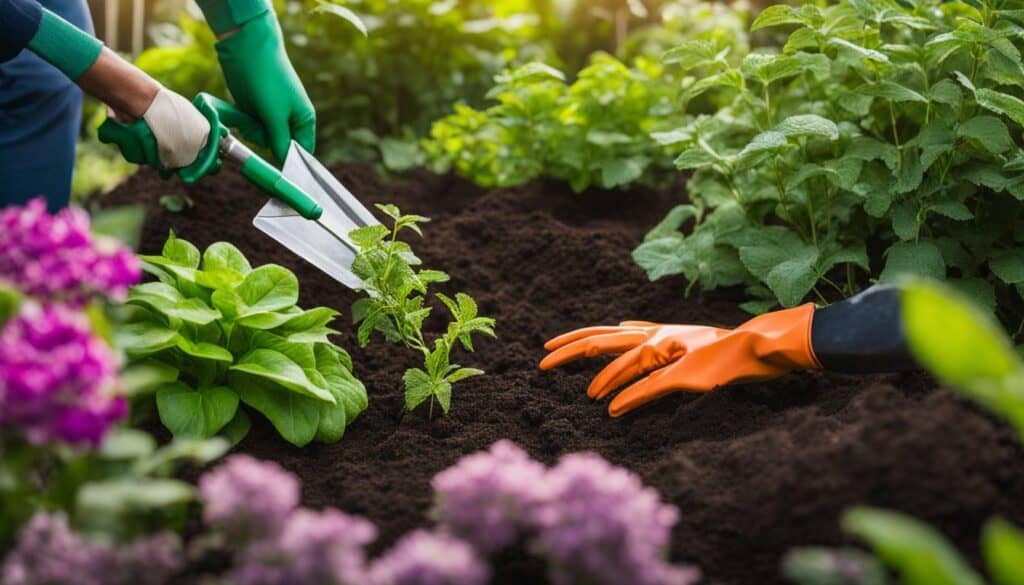
| Light Conditions | Recommended Plants |
|---|---|
| Full Sun | Roses, Sunflowers, Marigolds |
| Partial Sun | Hostas, Ferns, Hydrangeas |
| Shade | Astilbes, Impatiens, Hellebores |
Quote of the Day: “A successful garden starts with the right plants and well-prepared soil.” – Unknown
Key Takeaways
- Select plants based on sunlight exposure and your garden’s conditions.
- Prepare the soil by removing weeds and adding compost and organic matter.
- Ensure even distribution of amendments for optimal plant growth.
Digging and Turning the Soil: Maintaining a Healthy Garden
Digging and turning the soil play a crucial role in maintaining a healthy garden. By aerating the soil, you create a favorable environment for your plants’ roots to grow and absorb nutrients efficiently. But when is the optimal time to dig, and why is it vital for your garden’s overall well-being?
During the early spring, when the soil is no longer frozen, is the ideal time to start digging and turning the soil. This helps to break up any compacted areas, allowing air and moisture to penetrate the soil and reach the roots. It also provides an opportunity to remove any weeds or debris, preventing them from competing with your plants for nutrients and water.

Additionally, digging and turning the soil in early spring prepares it for future planting. By loosening the soil, it becomes light and fluffy, making it easier for plants to establish their roots and thrive. This is especially important if you are planning on starting a new garden or adding new plants to an existing one.
Remember that the fall is another essential time to turn the soil. By doing so, you expose beneficial microorganisms to the elements, helping to break down organic matter and enrich the soil. When winter arrives, the soil freezes and thaws, further enhancing its structure, making it ready for planting in the spring.
Benefits of Digging and Turning the Soil:
- Promotes aeration and nutrient absorption
- Prevents weed competition
- Removes debris and improves soil structure
- Prepares soil for planting
- Enhances microbial activity
By incorporating digging and turning the soil into your garden maintenance routine, you are setting the foundation for a healthy and thriving garden. So, grab your shovel and start digging to ensure your plants reach their full potential!
Watering and Weeding for Garden Success
Proper watering and regular weeding are key components of successful garden maintenance. Uncover the expert tips for efficient watering and effective weed control.
To ensure your plants stay hydrated, it’s important to water them properly. One of the most efficient strategies is to water deeply and less frequently. This encourages the roots to grow deeper into the soil, making your plants more resilient to drought. Consider using a soaker hose or drip irrigation system to deliver water directly to the roots, minimizing evaporation and water waste.
When it comes to weed control, prevention is key. Before planting, lay down a layer of organic mulch to suppress weed growth and conserve moisture in the soil. Regularly inspect your garden for weeds and remove them promptly, ensuring you pull out the entire root system to prevent regrowth. For stubborn weeds, consider using a targeted herbicide or vinegar-based spray for a more targeted approach.
Expert Tip: Mulch Matters
“Using mulch not only helps control weeds but also regulates soil temperature and retains moisture, reducing the need for frequent watering. Apply a 2 to 3-inch layer of mulch around your plants, leaving a small space around the stem to prevent moisture buildup and potential rot.”

| Watering Tips | Weed Control Tips |
|---|---|
|
|
Pest Control: Protecting Your Garden’s Health
Protecting your garden from pesky critters and harmful pests is crucial for maintaining its overall health and productivity. Discover effective methods to keep your garden pest-free.
When it comes to pest control, prevention is key. Implementing a few simple strategies can help you minimize the risk of infestations and keep your plants thriving. One effective method is to encourage beneficial insects, such as ladybugs and lacewings, to make your garden their home. These natural predators feed on common garden pests like aphids and caterpillars, providing a built-in defense system.
| Pest | Control Method |
|---|---|
| Aphids | Introduce ladybugs and lacewings or use organic insecticidal soap. |
| Slugs and snails | Place copper barriers or eggshells around vulnerable plants. |
| Caterpillars | Handpick or use Bacillus thuringiensis (BT) spray. |
In addition to attracting beneficial insects, practicing good garden hygiene is essential. Regularly remove dead leaves, fallen fruits, and other debris that can harbor pests and diseases. By keeping your garden clean and tidy, you eliminate potential hiding spots and breeding grounds for unwanted critters.
For stubborn infestations, consider using organic pest control products. These eco-friendly alternatives are formulated to target specific pests while minimizing harm to beneficial insects, wildlife, and the environment.
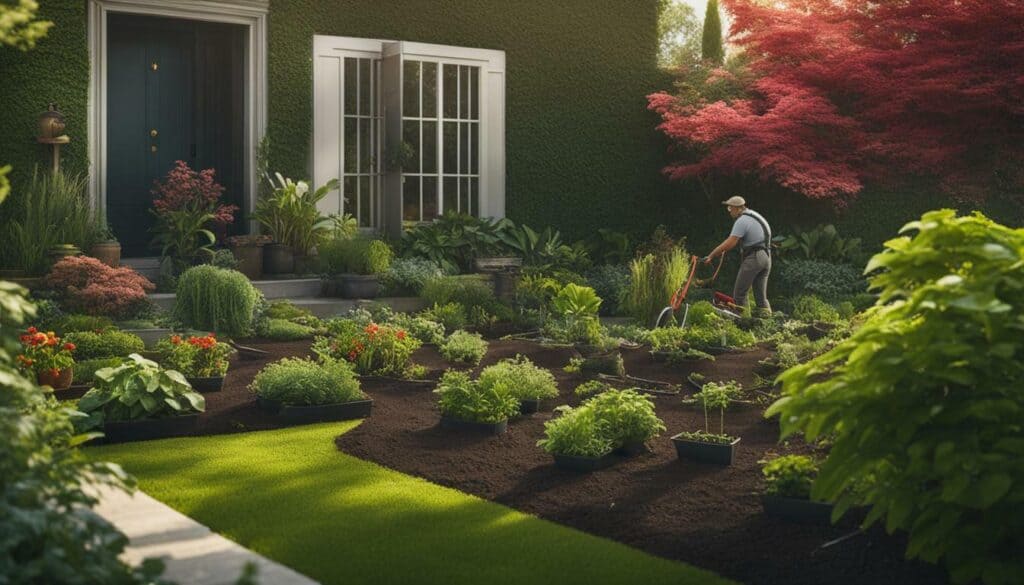
By following expert advice for maintaining gardens and implementing efficient garden maintenance strategies, you can ensure a healthy and thriving garden all year round. Take the necessary steps to protect your garden from pests, and watch as your plants flourish and bloom!
Starting Small and Expanding Gradually
Taking a gradual approach to garden maintenance not only eases the workload but also allows you to savor the progress and reap the rewards of your gardening efforts. Starting with a small garden gives you the opportunity to learn and experiment while keeping maintenance manageable. As you gain confidence and experience, you can gradually expand your garden, adding new plants and features to enhance its beauty.
When starting small, it’s important to choose plants that are suitable for your garden’s conditions and your level of expertise. Consider the amount of sunlight your garden receives and select plants that thrive in those conditions. This will ensure that your garden remains in top shape and reduces the risk of plant failure.
Preparing the soil is another crucial step in maintaining a successful garden. By adding compost and organic matter, you can improve the soil’s fertility and drainage, providing a healthy environment for your plants to grow. This will save you time and effort in the long run, as fertile soil requires less maintenance and provides better results.
| Easy Ways to Keep Your Garden in Top Shape |
|---|
| Start small and gradually expand |
| Choose plants suitable for your garden’s conditions |
| Prepare the soil with compost and organic matter |
| Water your plants regularly |
| Weed diligently |
| Implement pest control measures |
Regular watering, diligent weeding, and implementing effective pest control measures are essential for maintaining a healthy garden. Keeping your plants well-hydrated, removing weeds promptly, and protecting them from pests will ensure their optimal growth and prevent any potential damage.
As your garden expands, don’t forget to enjoy the journey. Take time to appreciate the progress you’ve made and the beauty that surrounds you. Gardening is a fulfilling and rewarding activity, and by starting small and expanding gradually, you can truly savor the pleasures of maintaining a thriving garden.
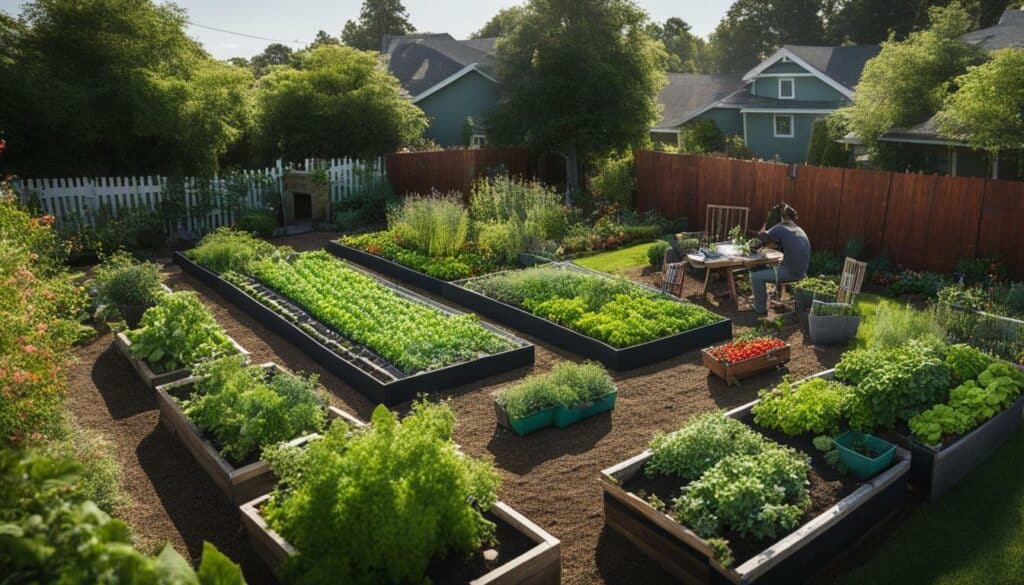
Gardening can be made easier by following some simple tricks and techniques. Learn how preparing the soil at strategic times and implementing other handy tips can streamline your garden maintenance.
To make garden soil soft and workable, it is recommended to dig up the soil in early spring and again in early April. This will aerate the soil and make it easier to work with. When turning the soil in the fall, it becomes light and fluffy, making it ready for planting in the spring.
Starting a garden requires selecting the right plants based on your preferences and the amount of sunlight your garden receives. It’s also important to prepare the soil by adding compost and organic matter. These steps will provide the necessary nutrients for your plants to thrive.
Watering, weeding, and pest control are essential for maintaining a healthy garden. Regular watering will keep your plants hydrated and promote healthy growth. Weeding helps to prevent unwanted plants from competing with your desired plants for resources. Implementing effective pest control measures will protect your garden from harmful insects and diseases.
Starting small and gradually expanding your garden will ensure that you can handle the workload and enjoy the rewards of your efforts. It allows you to learn and adjust your gardening techniques as you go. By taking these steps and following expert advice for maintaining gardens, you can create and maintain a beautiful garden space.

By implementing the expert advice and best practices discussed throughout this guide, you can ensure your garden thrives year after year, bringing you joy and beauty. Here are the key takeaways to remember:
- Prepare the soil: Digging up the soil in early spring and again in early fall aerates it, making it easy to work with. Adding compost and organic matter will enrich the soil and provide nutrients to your plants.
- Select the right plants: Choose plants that are suitable for your garden’s sunlight exposure. Consider your preferences and the growth requirements of the plants to ensure their success in your garden.
- Watering and weeding: Regular watering is essential to keep your plants hydrated, while diligent weeding eliminates competition for nutrients and helps your plants thrive.
- Pest control: Protect your garden’s health by identifying and combating common pests. Incorporate natural pest control methods and consider the use of organic pesticides when necessary.
- Start small and expand gradually: Begin your gardening journey with a small plot and gradually expand over time. This allows you to manage the workload effectively and enjoy the process of growing your garden.
- Utilize seasonal data: Take advantage of factual data to simplify your garden maintenance routine. Digging the soil in spring and fall, along with other seasonal tasks, can make gardening easier and more efficient.
By following these key takeaways and adopting a proactive approach to garden maintenance, you’ll create an environment where your plants can flourish. Remember, gardening is a journey of learning and experimentation, so don’t be afraid to try new things and adapt your practices to suit your garden’s unique needs.
| Garden Maintenance Tips | Benefits |
|---|---|
| Prepare the soil with compost and organic matter | Enriches soil, provides nutrients to plants |
| Select plants based on sunlight exposure | Ensures plants thrive in their preferred conditions |
| Regularly water and weed the garden | Keeps plants hydrated and minimizes competition |
| Implement effective pest control strategies | Protects plants from pests and diseases |
| Start with a small garden and expand gradually | Helps manage workload and enjoy the process |
| Utilize seasonal data for efficient maintenance | Simplifies gardening routine and maximizes results |
Remember, by incorporating these tips into your garden maintenance routine, you’ll be well on your way to cultivating a thriving and beautiful garden for years to come.
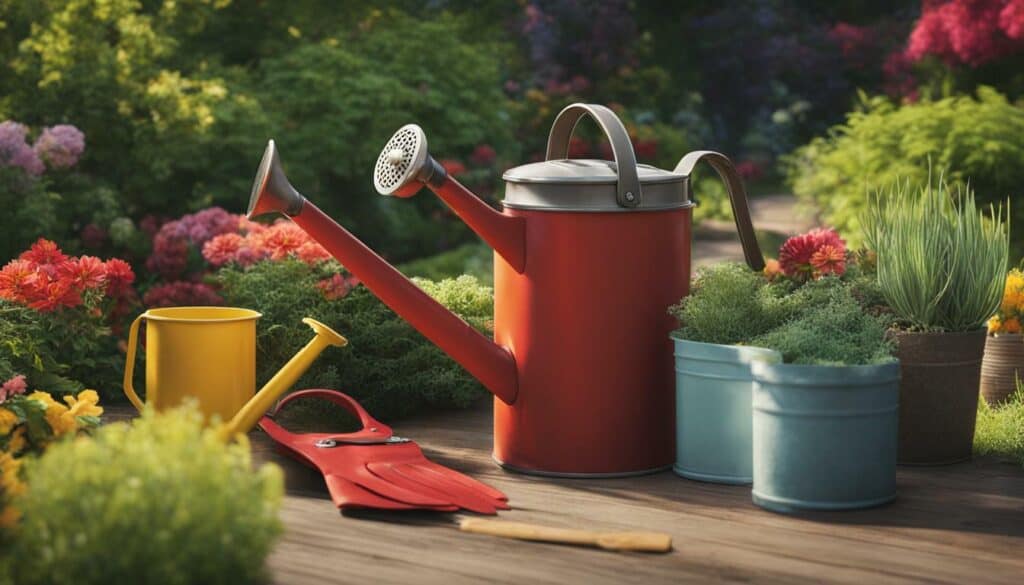
Maintaining a beautiful garden requires consistent care and attention, but with the tips and advice shared in this guide, you’ll be well-equipped to keep your garden flourishing.
To ensure that your soil is soft and workable, it’s recommended to dig up the soil in early spring and again in early April. This process helps to aerate the soil, making it easier to work with. Additionally, turning the soil in the fall will make it light and fluffy, ready for planting in the spring.
When starting your garden, it’s crucial to select the right plants based on your preferences and the amount of sunlight your garden receives. Preparing the soil by adding compost and organic matter will provide essential nutrients for your plants’ growth.
Watering, weeding, and pest control are vital for maintaining a healthy garden. Consistent watering ensures that your plants stay hydrated, while regular weeding keeps unwanted plants at bay. Implementing pest control strategies will safeguard your garden’s health and prevent damage from common garden pests.
Starting small and gradually expanding your garden is a practical approach that allows you to manage the workload and enjoy the rewards of a thriving garden. As you gain experience and confidence, you can expand your garden and experiment with different plants and designs.
By following these essential garden care techniques and expert advice for maintaining gardens, you’ll be on your way to establishing and maintaining a successful garden that brings beauty and joy to your outdoor space.
FAQ on How to Garden Maintain
Q: When is the best time to dig up the soil?
A: It is recommended to dig up the soil in early spring and again in early April to aerate it and make it easier to work with.
Q: How does turning the soil in the fall benefit the garden?
A: Turning the soil in the fall makes it light and fluffy, preparing it for planting in the spring.
Q: What should I consider when selecting plants for my garden?
A: Consider your preferences and the amount of sunlight your garden receives when selecting plants.
Q: How can I prepare the soil for planting?
A: Prepare the soil by adding compost and organic matter to ensure optimal plant growth.
Q: What are the essential tasks for maintaining a healthy garden?
A: Watering, weeding, and pest control are essential tasks for maintaining a healthy garden.
Q: How can I handle the workload of gardening?
A: Start small and gradually expand your garden to manage the workload effectively.
Q: What are some tips to make garden maintenance easier?
A: Digging up the soil in spring and fall, along with other methods, can make garden maintenance easier.
Q: What are the key takeaways for maximizing garden success?
A: Select the right plants, prepare the soil, maintain watering and weeding, control pests, and start small to maximize garden success.
Q: Why is regular garden maintenance important?
A: Regular garden maintenance is important for the health and growth of your plants.
What Are the Essential Steps for Lawn Garden Care Maintenance?
Proper lawn garden care maintenance requires several essential steps to ensure a vibrant and healthy outdoor space. Firstly, regular mowing is crucial to maintain an optimal grass height. Secondly, proper watering is essential, aiming for deep watering rather than frequent shallow watering. Additionally, incorporating proper fertilization and weed control techniques is necessary. Finally, seasonal aerating and regular maintenance of garden tools contribute to achieving a lush and thriving lawn garden. These lawn garden care tips revealed will help you achieve a gorgeous outdoor space.

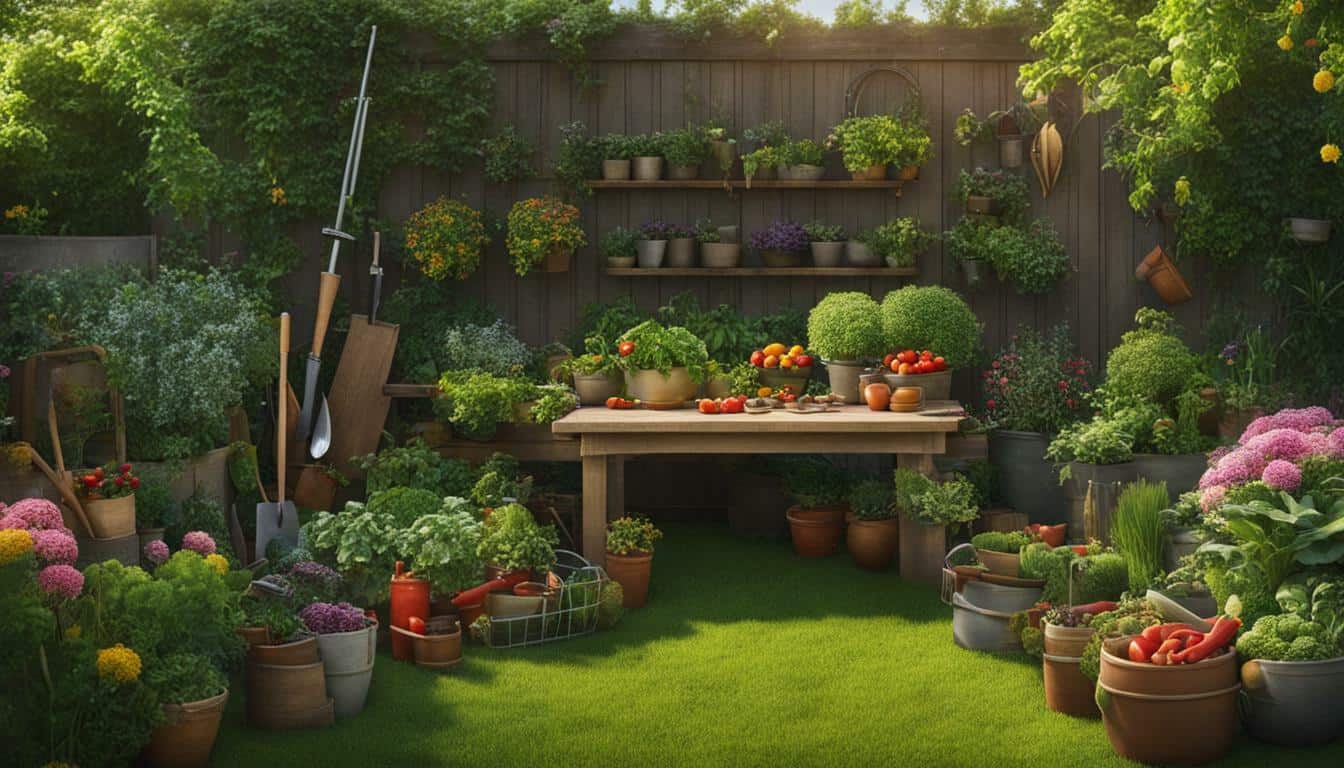



Leave a Reply